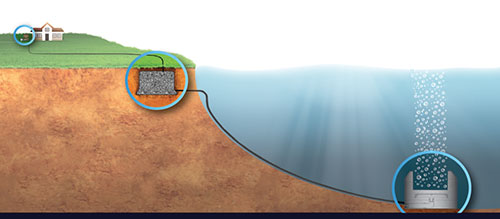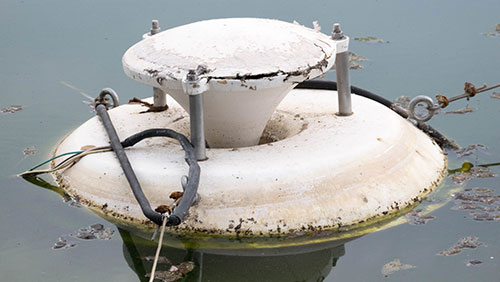Wastewater Aeration
Wastewater Aeration: What it Does and How it Works
What Wastewater Aeration Does
Wastewater aeration is the process of adding air to assist the aerobic microorganisms in the consumption of pollutants. Wastewater aeration is a vital part of most every biological treatment system. A well designed and operated wastewater aeration system will accomplish two main jobs:
-
-
- Adds air to the wastewater thus increasing the dissolved oxygen (DO) levels
- Mixes the wastewater
-
Adding Air to Wastewater
The first job of wastewater aeration is adding air to the wastewater. In a secondary biological treatment process, aerobic microorganisms consume the organic pollutants in the wastewater. These microorganisms require adequate dissolved oxygen or “DO” to thrive. Without sufficient oxygen, microorganisms are not able to consume the incoming organic pollutants in a reasonable time. In order to maintain DO levels, an aeration system is a must.
Mixing the Wastewater
The second job of wastewater aeration is mixing the wastewater. Proper mixing keeps solids in suspension thus avoiding a buildup of sludge. Mixing also ensures that there are no anaerobic (without air) zones in the wastewater. A common problem, especially with lagoons, is that there is less oxygen present on the bottom. Mixing makes sure all the water and microorganisms come into contact with oxygen.
How does Wastewater Aeration Work?
Sub-Surface Aeration
A sub-surface aeration system provides oxygen to microorganisms by injecting air into the wastewater. Blowers or air pumps compress the air which is delivered through airlines to diffusers installed on the bottom of the tank or lagoon. The diffusers are installed in a pattern on the bottom of the tank or lagoon for uniform coverage. The diffusers have tiny holes that create bubbles that come into contact with the water. Diffusers come in two basic types: fine bubble and course bubble.
Fine Bubble Diffusers
Fine bubble diffusers typically have thousands of tiny holes and produce the smallest bubbles. The smaller bubbles provide the maximum surface area for contact with the wastewater. They also rise to the surface at a slower rate which provides for a longer contact time. These two factors make fine bubble diffusers the best choice for what is called “Oxygen Transfer Efficiency”. Oxygen transfer efficiency is the amount of air absorbed by the wastewater as a percentage of the amount of air produced by the aeration system.
Course Bubble Diffusers
Course bubble diffusers typically have a few larger holes that produce larger bubbles. These larger bubbles travel faster to the surface than the fine bubbles. This aspect creates more turbulence and mixing in the wastewater. Course bubble diffusers are an excellent choice in situations where mixing is most important. It should be noted that course bubble diffusers can require twice as much air to operate as fine bubble diffusers.

A sub-surface aeration system consists of a compressor or blower, a valve system to distribute air and finally a diffuser located on the bottom of the lagoon.
Surface Aeration
Surface aeration of wastewater is used in lagoon or pond treatment systems. Equipment used for wastewater surface aeration includes low waterfalls, jet fountains and spray nozzles. These can be fixed or on pontoons. Wastewater comes into contact with the air through the agitation created when it is sprayed or transported. This type of aeration creates the maximum possible mixing and a high level of oxygen transfer to the wastewater it comes in contact with. The drawback of surface aeration is that it’s effects are limited to the area of the lagoon around the aerator.

This is an example of a fountain used for surface aeration. While it does a great job of mixing the water near the surface of the pond, it does not mix near the bottom.
Wastewater Aeration as Part of a Treatment Process
Wastewater aeration is typically used during the secondary treatment process. This process is most often an activated sludge process. Aeration in an activated sludge process is accomplished by pumping air into the tank or lagoon. Proper aeration promotes the growth of microorganisms or microbes in the wastewater. The microbes feed on the organic pollutants and form flocs which can easily settle out. The flocs are allowed to settle out in a separate settling tank or lagoon. The flocs of bacteria that settle and accumulate on the bottom of the tank or lagoon form activated sludge. The activated sludge can then be recirculated back to the aeration basin or lagoon to increase the rate of consumption of pollutants.
Wastewater aeration is also used in tanks and lagoons used for storage. Examples of these storage tanks and lagoons would be ones used as sludge holding and flow equalization. In these portions of a wastewater treatment system (tank or lagoon) it is important to maintain the living microorganisms. If the microorganisms begin to die, the wastewater will become septic and odor will start to be an issue.
ProLake™ Laminar Flow Technology for Lagoon Aeration and Mixing
ProLake™ has invented elegant, yet simple, solutions to the problem of aerating waste water lagoons. ProLake™ has designed aeration systems utilizing solar powered or low horsepower, electrical, sub-surface diffused aeration. Expandable rubber membrane diffusers produce a laminar flow of bubbles. This type of diffuser has thousands of tiny openings that create small fine bubbles at low flow.
A laminar flow of small bubbles is advantageous in that they have a greater surface area for the absorption of oxygen into the water. Additionally, the smaller bubbles in a laminar flow move slower than larger bubbles which provides additional contact time. Also, because the smaller bubbles have a greater surface area, the laminar flow of bubbles pushes water vertically to create a columnar flow of water.
The Duraplate™ Diffuser directs the laminar flow of bubbles and assists in creating a columnar flow of water that is drawn from hole at the bottom of the tube. This creates circulation of water from the bottom of the body of water.

Laminar flow aeration systems create a roll pattern in a lagoon for complete mixing.
-
-
- The diffuser pulls in the Water
- The water is Oxygenated
- Water is transported up to the surface
- A laminar current is created
-
We offer a full line of aeration products from ProLake™
Click here to see the full line of ProLake™ wastewater lagoon aeration systems we carry.
